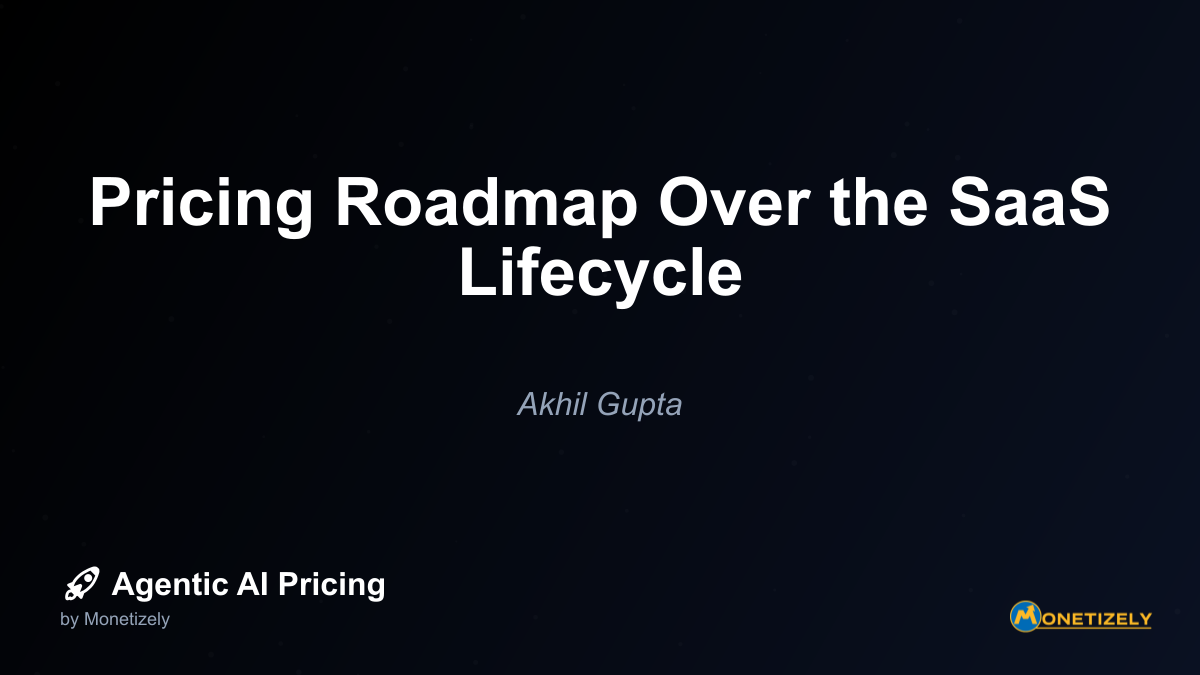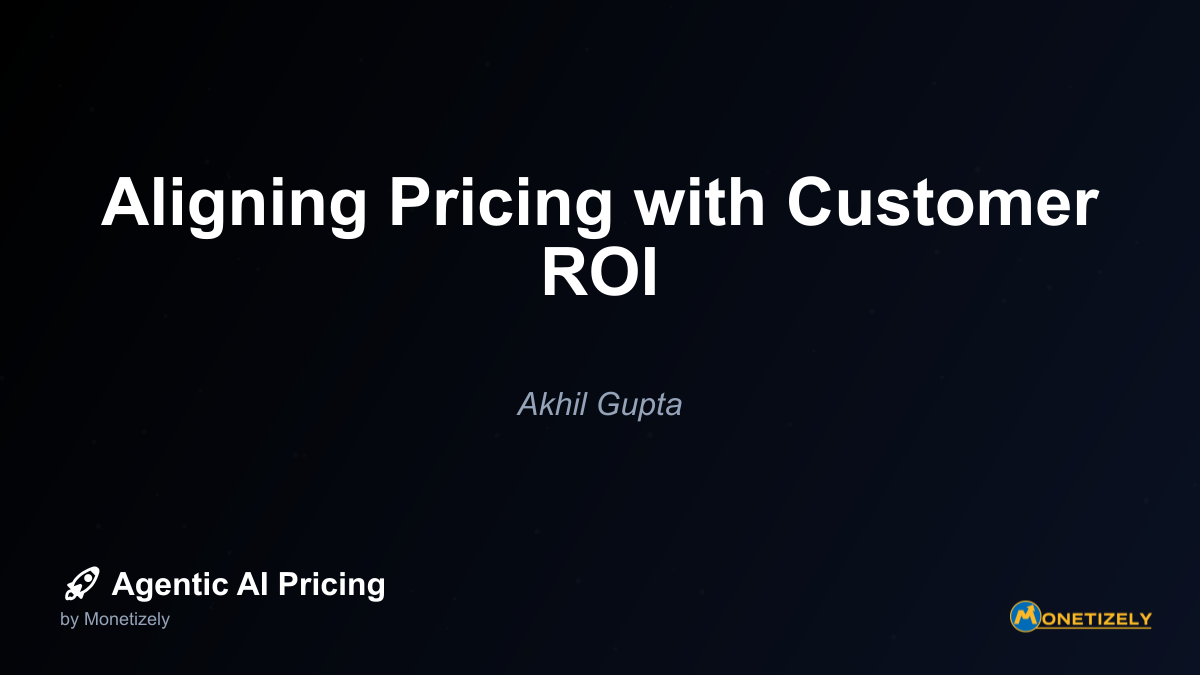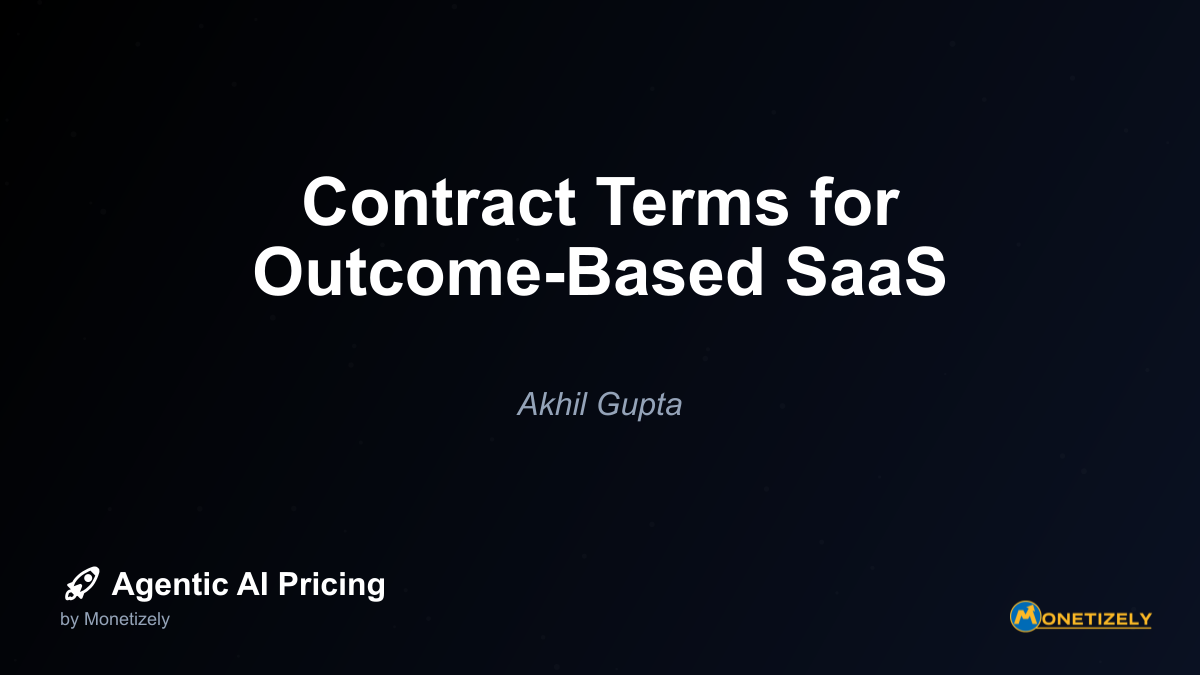· Akhil Gupta · Pricing Agentic SaaS Products · 12 min read
Pricing Roadmap Over the SaaS Lifecycle
AI and SaaS Pricing Masterclass
Learn the art of strategic pricing directly from industry experts. Our comprehensive course provides frameworks and methodologies for optimizing your pricing strategy in the evolving AI landscape. Earn a professional certification that can be imported directly to your LinkedIn profile.

In the rapidly evolving landscape of software-as-a-service (SaaS), pricing strategy serves as a critical lever for business growth and sustainability. As products mature from early-stage innovations to established market players, pricing approaches must evolve accordingly to reflect changing value propositions, market conditions, and organizational capabilities. This is especially true for agentic AI products, where traditional pricing models often fail to capture the unique value dynamics of autonomous systems.
Understanding the SaaS Lifecycle and Its Pricing Implications
The SaaS product lifecycle typically progresses through distinct phases: early stage (ideation and launch), growth, maturity, and eventually decline or renewal. Each stage presents unique challenges and opportunities for pricing strategy.
Early Stage: Focus on Adoption and Learning
In the nascent phase of a SaaS product, pricing strategy primarily serves to facilitate adoption and gather crucial market feedback. At this stage, companies often prioritize user acquisition over immediate profitability.
Key Pricing Strategies for Early Stage:
Freemium Models: Offering a functional free tier to drive adoption while reserving premium features for paid plans. This approach reduces barriers to entry while establishing value perception.
Low-Barrier Entry Pricing: Setting initial prices deliberately low to encourage experimentation and reduce purchase friction.
Simple Pricing Structures: Limiting complexity with straightforward tiers or single-plan offerings that are easy to understand and purchase.
Introductory Discounts: Providing time-limited promotional pricing to early adopters to accelerate initial growth.
During this phase, the primary metrics to track include:
- Conversion rates from free to paid tiers
- Feature usage patterns
- Customer acquisition cost (CAC)
- Initial feedback on pricing and value perception
For agentic AI products specifically, early-stage pricing often focuses on demonstrating tangible value through outcome-based metrics rather than traditional user-based pricing. Companies might price based on specific AI capabilities delivered or tasks completed rather than seat licenses.
Growth Stage: Balancing Acquisition with Monetization
As the product gains traction and establishes product-market fit, the pricing strategy shifts toward optimizing revenue while maintaining growth momentum. This stage typically sees the introduction of more sophisticated pricing structures.
Key Pricing Strategies for Growth Stage:
Value-Based Pricing Refinement: Adjusting pricing based on demonstrated value metrics and customer willingness to pay.
Tiered Pricing Expansion: Introducing additional tiers to capture different customer segments and use cases.
Feature-Based Differentiation: Clearly delineating value between pricing tiers through strategic feature allocation.
Usage-Based Components: Introducing consumption-based elements to capture value from higher-usage customers.
Annual Billing Incentives: Offering discounts for annual commitments to improve cash flow and reduce churn.
During the growth phase, companies should monitor:
- Average revenue per user (ARPU)
- Customer lifetime value (CLTV)
- Expansion revenue and upsell conversion rates
- Churn rates by pricing tier
- Price sensitivity across different customer segments
For agentic AI products, the growth stage often sees a transition to hybrid pricing models that combine subscription components with usage-based elements. For instance, charging a base subscription fee for access to the AI platform while adding consumption-based pricing for specific AI compute resources or outcomes.
As OpenAI demonstrated in its evolution from pure API usage pricing to tiered subscription plans with token limits, growth-stage AI companies must balance computational cost management with customer value perception.
Maturity Stage: Optimizing for Profitability and Retention
In the maturity phase, the focus shifts toward maximizing profitability while defending market position against competitors. Pricing strategy becomes more sophisticated, with greater emphasis on customer segmentation and value extraction.
Key Pricing Strategies for Mature Stage:
Premium Tier Expansion: Introducing enterprise-grade offerings with advanced features, support, and customization options.
Value-Based Pricing Optimization: Refining pricing based on extensive usage data and customer value realization.
Cross-Sell and Add-On Monetization: Creating additional revenue streams through complementary products or services.
Strategic Discounting: Implementing segment-specific discount structures to maximize revenue without undermining value perception.
Price Increase Management: Carefully implementing periodic price adjustments for existing customers based on enhanced value delivery.
Key metrics for mature stage pricing include:
- Net revenue retention
- Profit margins by customer segment
- Price realization rates
- Competitive win/loss analysis
- Customer satisfaction with pricing
For agentic AI products in maturity, outcome-based pricing often becomes more sophisticated, with pricing tied directly to business results achieved. Companies might implement “AI agent seats” pricing (similar to human user seats but for autonomous AI workers) or create industry-specific pricing packages tailored to particular use cases.
Decline/Renewal Stage: Pricing for Sustainability
In the final stage of the lifecycle, products either face declining demand or undergo significant reinvention. Pricing strategy must adapt accordingly, either to maximize remaining value or to support a product transformation.
Key Pricing Strategies for Decline/Renewal Stage:
Pricing Simplification: Streamlining complex pricing structures to reduce overhead and friction.
Legacy Customer Management: Creating specific programs to retain and maximize value from existing customers.
Bundle Pricing: Combining the product with other offerings to maintain relevance and value.
Pricing for Transition: Using pricing incentives to migrate customers to newer product versions or alternatives.
Metrics to focus on during this stage include:
- Customer retention rates
- Cost to serve
- Migration success rates
- Legacy product profitability
Implementing a Pricing Roadmap Across the SaaS Lifecycle
Developing a comprehensive pricing roadmap requires a strategic approach that anticipates future needs while addressing current market realities. Here’s a step-by-step framework for implementing pricing changes throughout the lifecycle:
1. Establish a Pricing Governance Structure
The ownership of pricing decisions should evolve with the company:
Early Stage: Founders and product leaders typically own pricing decisions, ensuring alignment with product vision and market positioning.
Growth Stage: Dedicated product marketing or pricing managers take greater ownership, integrating customer insights and competitive data into pricing decisions.
Maturity Stage: Cross-functional pricing teams involving finance, marketing, product, and sales develop and refine pricing strategy with robust governance processes.
Companies should establish clear decision-making processes, approval workflows, and communication protocols for pricing changes at each stage.
2. Develop a Value Metric Evolution Plan
Value metrics—the units by which you charge customers—should evolve as your product and market understanding matures:
- Early Stage: Simple value metrics like number of users, basic features, or storage.
- Growth Stage: More sophisticated metrics aligned with customer value, such as active usage, transactions processed, or outcomes achieved.
- Maturity Stage: Highly refined metrics that precisely capture value delivered, potentially including industry-specific or outcome-based measurements.
For agentic AI products, this evolution is particularly important as value metrics shift from traditional SaaS measures (like user seats) to AI-specific metrics such as:
- Autonomous tasks completed
- Compute resources consumed
- Business outcomes generated
- AI agent seats or instances
3. Plan Strategic Price Change Timing
Timing is critical when implementing pricing changes:
- Major Product Enhancements: Align price changes with significant feature additions or performance improvements.
- Market Condition Shifts: Adjust pricing in response to competitive movements or changing economic conditions.
- Cost Structure Changes: Update pricing when underlying costs (like cloud infrastructure or AI compute) significantly change.
- Annual Business Planning: Coordinate pricing updates with fiscal year planning cycles.
According to industry research, 94% of SaaS leaders update pricing or packaging at least once per year, with 98% having done so since 2022 to stay competitive amid macroeconomic challenges.
4. Design Effective Communication and Migration Strategies
How you communicate pricing changes significantly impacts their reception:
- Early Stage: Focus on value communication and establishing pricing norms.
- Growth Stage: Develop more sophisticated communication that emphasizes ROI and competitive differentiation.
- Maturity Stage: Implement comprehensive communication plans with tailored messaging for different customer segments.
For existing customers facing price changes, consider these migration approaches:
- Grandfathering: Allow existing customers to maintain current pricing indefinitely or for a defined period.
- Phased Migration: Gradually transition customers to new pricing through stepped increases.
- Value-Added Migration: Bundle additional features or services with price increases to enhance perceived value.
- Opt-in Incentives: Offer incentives for voluntarily adopting new pricing structures.
5. Implement Robust Testing and Measurement Frameworks
Before rolling out pricing changes broadly, establish testing methodologies:
- A/B Testing: Test different pricing structures with comparable customer segments.
- Cohort Analysis: Track performance metrics across different pricing cohorts over time.
- Customer Interviews: Gather qualitative feedback on pricing perception and value alignment.
- Sales Team Feedback: Collect insights from frontline teams about pricing objections and competitive positioning.
Key metrics to track before and after pricing changes include:
- Conversion rates at different funnel stages
- Customer acquisition costs relative to lifetime value
- Expansion revenue and upsell success
- Churn rates and reasons
- Price realization (actual vs. list price)
- Customer satisfaction and NPS scores
Special Considerations for Agentic AI Products
Agentic AI products present unique pricing challenges that traditional SaaS pricing models often fail to address adequately. Here are key considerations for pricing AI products across lifecycle stages:
The Shift from User-Based to Value-Based Metrics
Traditional SaaS often relies on per-user pricing, assuming value is directly tied to the number of human users. However, agentic AI delivers value through autonomous actions, real-time predictions, or outcomes that are independent of user count. This fundamental difference necessitates new pricing approaches:
- API/Token-Based Pricing: Charging based on API calls or token consumption (like OpenAI’s approach).
- Outcome-Based Pricing: Billing based on measurable results like tasks completed or revenue generated.
- AI Agent Seat Pricing: Pricing tied to AI agents’ activity rather than human users.
- Hybrid Models: Combining subscription access with usage-based components for AI workloads.
Cost Structure Considerations
Unlike traditional SaaS where adding users has minimal incremental cost, AI features often come with substantial operational costs for compute resources and data processing. Pricing models must account for these expenses to maintain profitability:
- Early Stage: Simple usage limits with overage charges to protect against excessive costs.
- Growth Stage: More sophisticated usage tiers with volume discounts that still ensure margin protection.
- Maturity Stage: Highly optimized pricing that precisely balances value delivery with cost management.
Communicating AI Value Effectively
The abstract nature of AI capabilities can make value communication challenging:
- Early Stage: Focus on concrete outcomes and tangible benefits rather than technical capabilities.
- Growth Stage: Develop ROI models and case studies demonstrating quantifiable value.
- Maturity Stage: Create industry-specific value narratives and sophisticated ROI calculators.
Case Studies: Successful Pricing Evolution Across the SaaS Lifecycle
Early Stage: Slack’s Freemium Strategy
Slack initially offered a generous free tier to drive rapid adoption while monetizing through premium features for larger teams and enterprises. This approach allowed them to:
- Achieve viral growth through bottom-up adoption
- Gather extensive usage data to inform later pricing decisions
- Establish clear value differentiation between free and paid tiers
- Create natural upgrade paths as team usage expanded
The strategy proved highly effective, with Slack reaching a $1 billion valuation faster than almost any previous SaaS company.
Growth Stage: HubSpot’s Tiered Evolution
HubSpot’s pricing evolution exemplifies successful growth-stage strategy:
- Initial Focus: Started with a simple, single-product pricing model for their marketing platform.
- Expansion: Gradually introduced additional products (Sales Hub, Service Hub) with their own tiered pricing.
- Bundle Creation: Developed bundle discounts to encourage multi-product adoption.
- Enterprise Tier Development: Built out sophisticated enterprise offerings with advanced features and services.
This evolution allowed HubSpot to increase average contract value from under $10,000 to over $30,000 for many enterprise customers while maintaining strong growth.
Maturity Stage: Adobe’s Subscription Transformation
Adobe’s transition from perpetual licensing to subscription pricing represents one of the most successful pricing pivots in software history:
- Initial Challenge: Faced declining growth and rampant piracy with traditional perpetual license model.
- Strategic Shift: Moved to Creative Cloud subscription model despite short-term revenue impact.
- Value Enhancement: Continuously added new features, cloud services, and mobile capabilities.
- Outcome: Increased recurring revenue predictability, reduced piracy, and ultimately grew total revenue substantially.
Adobe’s stock price increased more than tenfold in the decade following this pricing transformation.
AI-Specific Example: OpenAI’s Pricing Evolution
OpenAI’s pricing journey illustrates the unique challenges of AI product pricing:
- Initial Approach: Pure usage-based API pricing based on token consumption.
- Growth Challenge: Faced balancing accessibility with the high compute costs of large language model operations.
- Tiered Evolution: Introduced ChatGPT Plus subscription tier with priority access and usage allowances.
- Enterprise Expansion: Developed enterprise-specific pricing with additional security, support, and customization.
This evolution demonstrates the need for AI companies to balance computational cost management with customer value perception as they grow.
Common Pitfalls in SaaS Lifecycle Pricing
Early Stage Pitfalls
- Underpricing: Setting prices too low initially, creating challenges for later increases.
- Overcomplicating: Creating unnecessarily complex pricing before understanding customer segments.
- Ignoring Unit Economics: Failing to account for customer acquisition costs relative to lifetime value.
- Misaligned Value Metrics: Choosing pricing units that don’t scale with customer value.
Growth Stage Pitfalls
- Delayed Price Evolution: Maintaining early-stage pricing too long despite increased product value.
- Inconsistent Discounting: Allowing excessive or inconsistent discounting that undermines price integrity.
- Feature Dilution: Adding too many features to lower tiers, reducing upsell incentives.
- Competitive Fixation: Focusing too much on competitor pricing rather than unique value proposition.
Maturity Stage Pitfalls
- Overly Complex Pricing: Creating pricing structures so complex that customers and sales teams struggle to understand them.
- Mishandled Price Increases: Implementing price changes without adequate value communication or migration planning.
- Neglecting Customer Segmentation: Using one-size-fits-all pricing despite diverse customer needs and willingness to pay.
- Failure to Innovate: Maintaining legacy pricing approaches despite market changes or new monetization opportunities.
Implementing Effective Pricing Changes: A Practical Guide
Executing pricing changes requires careful planning and cross-functional coordination. Here’s a step-by-step process for implementing pricing changes at each lifecycle stage:
1. Preparation Phase
- Define Clear Objectives: Establish specific goals for the pricing change (e.g., increase ARPU by 15%, reduce churn by 5%).
- Conduct Market Research: Gather competitive intelligence and customer willingness-to-pay data.
- Perform Impact Analysis: Model the financial impact across customer segments and overall business.
- Develop Migration Strategy: Create detailed plans for transitioning existing customers.
2. Internal Alignment
- Executive Sponsorship: Secure leadership buy-in with clear presentation of objectives and expected outcomes.
- Sales Enablement: Develop comprehensive training materials, objection handling guides, and updated sales collateral.
- Customer Success Preparation: Equip customer-facing teams with communication scripts and retention strategies.
- Technical Readiness: Ensure billing systems, CRM, and other infrastructure can support the new pricing structure.
3. Communication Strategy
- Timing Planning: Determine optimal timing for announcements (typically avoiding busy seasons or financial year-ends).
- Segmented Messaging: Create tailored communications for different customer segments.
- Value Reinforcement: Clearly articulate enhanced value delivery that justifies pricing changes.
- Channel Selection: Determine appropriate communication channels (email, in-app notifications, direct calls) by customer tier.
4. Implementation and Monitoring
- Phased Rollout: Consider implementing changes to a subset of customers first to validate approach.
- Real-Time Metrics Tracking: Monitor key performance indicators daily during the transition period.
- Feedback Collection: Establish channels for gathering customer and sales team feedback.
- Adjustment Mechanisms: Prepare contingency plans for addressing unexpected issues or resistance.
Tools and Resources for SaaS Lifecycle Pricing
Several specialized tools can support pricing strategy development and implementation across the lifecycle:
Analytics and Pricing Intelligence
- ProfitWell: Subscription analytics and pricing optimization tools.
- Price Intelligently: Research-driven pricing strategy development.
- ChartMogul: SaaS metrics and subscription analytics.
- Paddle: Revenue delivery platform with pricing optimization features.
Billing and Subscription Management
- Chargebee: Flexible subscription billing platform supporting complex pricing models.
- Zuora: Enterprise-grade subscription management for mature SaaS businesses.
- Stripe Billing: Customizable billing
Co-Founder & COO
Akhil is an Engineering leader with over 16+ years of experience in building, managing and scaling web-scale, high throughput enterprise applications and teams. He has worked with and led technology teams at FabAlley, BuildSupply and Healthians. He is a graduate from Delhi College of Engineering and UC Berkeley certified CTO.
Pricing Strategy Audit
Let our experts analyze your current pricing strategy and identify opportunities for improvement. Our data-driven assessment will help you unlock untapped revenue potential and optimize your AI pricing approach.




